Posted by Anita on 03.19.10 11:06 PM
 Trying to plan a suitable entry for this month’s CanJam — the theme is alliums — left us a little perplexed. It’s not that we haven’t been known to preserve onions: I’m a big fan of the bright-pink Yucatecan pickled onions served with cochinita pibil, and Cameron has a special fondness for English-style pub onions.
Trying to plan a suitable entry for this month’s CanJam — the theme is alliums — left us a little perplexed. It’s not that we haven’t been known to preserve onions: I’m a big fan of the bright-pink Yucatecan pickled onions served with cochinita pibil, and Cameron has a special fondness for English-style pub onions.
But because we prefer them very crisp, we usually make both of these recipes as refrigerator pickles. (Processing seals the jars and kills any lingering toxins, but it also cooks whatever’s in the jar.) Neither of us really cares for sweet condiments with our savory dishes, so onion jams were out.
Then it occurred to me: Giardiniera.
Now, strictly speaking, onions are just one of this Italian-style pickle’s many components, but the little devils take an ungodly amount of time to prep, way more than all of the other parts combined. First you have to slice off the hair-like root end, but oh-so-carefully so as to not dislodge the onion’s layers from one another. Then you have to peel each tiny onion — no mean feat when natural sugars keep papery skins adhered firmly to outer layers of the onion’s flesh — without cutting them in half or otherwise mangling them.
It’s a labor of love, I tell you, but it’s all worth it when you open up that first jar and taste. The onions are integral part of giardiniera, the linchpin of its piquant flavor.
Giardiniera means “gardener” in Italian, the implication being that this hodgepodge of different vegetables would be a great way to preserve the bounty of an active kitchen plot. But its traditional components — red peppers, carrots, celery, onions, and cauliflower — are never simultaneously seen in abundance in any garden I’ve ever known. Even in Italy, I think you’d be hard-pressed to find red peppers and cauliflower in the same patch. (I did a little research on how this seasonal impossibility got its start, and came up empty; if anyone knows how these ingredients ended up in a single pickle, I’d love to hear!)
Other than the peppers, though, we’re able to get everything we need from our own garden, or nearby farmers, even in late winter. In place of the bell peppers, I used a bunch of skin-on piquillo peppers I’d stashed in the freezer last summer, but added them to the mixture just before portioning the cooked vegetables into the jars, to avoid softening them any further. Their texture wasn’t so hot, but they’re mostly there for color, anyway. Next year, I might just — shhh! — buy an imported pepper or two.

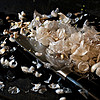
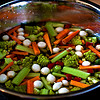

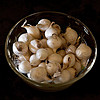
Giardiniera (Italian-style Pickled Vegetables)
— adapted from Sunset Canning, Freezing, and Drying
1/2 pound carrots*
1/2 pound celery*
2 red bell peppers
1 large cauliflower or romanesco
1 pound small white pearl onions
1 cup pickling salt
2 quarts white vinegar
1/4 cup mustard seed
2T celery seed
1 small dried hot pepper
1-1/2 cups sugar
Peel carrots, then cut into 1-1/2-inch by 1/4-inch sticks; you should have about 4 cups*. Remove strings from the celery, then cut into into 1-1/2-inch by 1/2-inch planks; you should have about 3 cups*. Stem and seed the peppers peppers, then cut into wide strips. Break the cauliflower into florets; trim the stems. Carefully peel the onions, leaving the root intact. Try not to swear.
In a very large bowl, dissolve the pickling salt in 4 quarts cold water. Add the vegetables to the brine, and refrigerate for 12 to 18 hours. Drain the vegetables, rinse in cold water, and drain again.
Prepare canner, lids, and 6 pint jars according to the usual method.
 Combine the vinegar, mustard seed, celery seed, chili pepper, and sugar in a 6-quart stainless or enamel pan. Bring to a boil and continue to cook for 3 minutes. Add the vegetables, reduce heat to low, and cook for a few minutes until the vegetables just begin to soften. Remove from heat and discard the chili.
Combine the vinegar, mustard seed, celery seed, chili pepper, and sugar in a 6-quart stainless or enamel pan. Bring to a boil and continue to cook for 3 minutes. Add the vegetables, reduce heat to low, and cook for a few minutes until the vegetables just begin to soften. Remove from heat and discard the chili.
Using a funnel, pack vegetables into hot jars up to just shy of 1/2 inch of the rim. Ladle hot pickling liquid to cover vegetables, leaving 1/2-inch headspace.
Remove air bubbles and adjust headspace; wipe rims and apply lids and rings.
Place jars in canner, ensuring they are completely submerged. Bring to a boil and process covered for 5 minutes. Remove canner lid; wait 5 minutes, then remove jars. Cool, check for seals, and store in a cool, dark place for up to a year.
—
* Note: After reading comments from a friend and long-time reader, I suspect that my weight-to-volume measurements are incorrect here. Please see this comment and this follow-up.
CanJam, Italian, locavore, preserving & infusing
10 Comments »




Posted by Anita on 03.15.10 9:48 PM
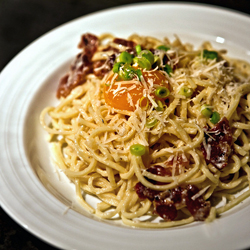 When you stock your larder with good quality staples, you’re able to create some amazing, quick weeknight meals. We’re lucky to live in a part of the country with access to a year-round supply of pastured eggs, a wide assortment of local artisan-made cheeses, and some truly excellent dry pasta, all from local sources.
When you stock your larder with good quality staples, you’re able to create some amazing, quick weeknight meals. We’re lucky to live in a part of the country with access to a year-round supply of pastured eggs, a wide assortment of local artisan-made cheeses, and some truly excellent dry pasta, all from local sources.
We’re also blessed to have good friends with amazing food-crafting skills. A case in point: Our friend Sean made his own house-cured guanciale, and generously gifted us with a chunk of the most delicious pork product we’ve tasted in recent memory.
Although Laura’s birthday dinner last Sunday could technically have been my Dark Days Challenge dinner for the week, I felt pretty happy knowing we’d be able to throw together an all-local meal, even though I’d missed the weekly farmer’s market during my Seattle trip. With Sean’s home-cured guanciale in our stash, along with a fresh dozen eggs from last week’s Soul Food Farm CSA delivery, we were only a few ingredients away from one of Cameron’s favorite simple suppers.
Two things set this pasta carbonara recipe apart from the usual. First, we added slivered green garlic as a garnish, an embellishment that’s sure to be frowned upon by carbonara purists, but one we’ll keep making as long as Knoll Farms keeps supplying our weekly fix. The second innovation is simple but revelatory: Separating the eggs and stirring the hot pasta with just the whites, then topping each serving with its own yolk to be stirred in at the table. This small trick lends the sauce a silky quality, and adds a little flair to the proceedings — just the trick for making a quick midweek supper worthy of an ingredient that took weeks to make.

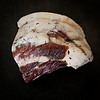
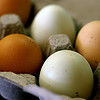
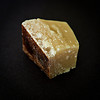
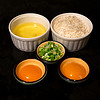
Spaghetti alla Carbonara
— adapted from Molto Italiano
1-1/2 T extra virgin olive oil
4oz guanciale (or pancetta)
1/2 pound spaghetti
3/4 cup freshly grated Parmesan
2 large eggs, separated
1 green garlic, white and light green parts, sliced thin
freshly ground black pepper
In a large pot, bring 4 quarts of well-salted water to a boil. Meanwhile, cut the gianciale into flat pieces, then combine the olive oil and guanciale in a large skillet over medium heat. Cook until the guanciale has rendered its fat, and becomes juicy and lightly browned. Remove the guanciale to a plate; remove the pan from the heat and set aside, reserving the fat in the pan.
Cook the spaghetti in the boiling water until just al dente. Add a good spoonful of the pasta water to the pan with the guanciale fat; drain the pasta. Return the guanciale to the pan, then add the pasta. Turn the heat back to medium-high and shake/toss the pasta with the water, fat, and guanciale for about a minute. Remove the pan from the heat and add 1/2 cup of the cheese, the egg whites, and freshly ground black pepper to taste; toss until thoroughly mixed (the egg whites will cook from the heat of the pasta).
Divide the pasta into nest-like piles between two warmed pasta bowls. Gently slide an egg yolk into the middle of each nest, then season with more pepper, the rest of the cheese, and the green garlic. Serve immediately, allowing each diner to stir the yolk into their own serving.
 Farmers and food artisans who created the ingredients for this week’s meal:
Farmers and food artisans who created the ingredients for this week’s meal:
Guisto’s Vita-Grain, South San Francisco: sea salt
Bariani, Sacramento: olive oil
Hedonia, San Francisco: guanciale (from Prather pork jowls)
Eduardo’s, San Francisco: spaghetti
Spring Hill Cheese Company, Petaluma: dry Jack cheese
Soul Food Farm, Vacaville: eggs
Tairwa Knoll Farms, Brentwood: green garlic
exemptions: black pepper
Dark Days challenge, Italian, locavore, meat, other blogs
3 Comments »




Posted by Anita on 01.19.09 7:54 AM
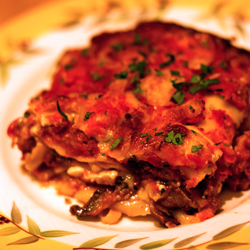 It must happen to everyone: That moment when you lose all ambition for trying new recipes and just fall back on the tried and true, the comfort foods that make your heart and belly happy, with a minimum of fuss.
It must happen to everyone: That moment when you lose all ambition for trying new recipes and just fall back on the tried and true, the comfort foods that make your heart and belly happy, with a minimum of fuss.
Last week, Cameron came down with a doozy of a cold. It wasn’t really terrible, in the symptoms department, but it seemed to go on forever and ever. It wasn’t the end of the world, but it was just annoying enough to keep him home, working at the dining room table and sipping mug after mug of lemon and honey. In much the same way, taking care of the house and the dogs all on my own isn’t really traumatic, but it is time-comsuming… and the thought of coming home and spending an hour or more in the kitchen — especially all alone — wasn’t terribly appealing. I looked for recipes that I could prep, preferrably in the morning or the night before, and then pop into the oven when I got home. And, of course, they had to appeal to the palate of a guy who had a head full of winter weather.
 Unfortunately for you, and for my narrative, the two all-local meals we ate last week were both repeats: My mom’s famous meatloaf — with Dirty Girl romanesco and baked Little’s potatoes on the side — and a thrown-together lasagna using home-canned tomatoes, locally made cheeses and fresh pasta.
Unfortunately for you, and for my narrative, the two all-local meals we ate last week were both repeats: My mom’s famous meatloaf — with Dirty Girl romanesco and baked Little’s potatoes on the side — and a thrown-together lasagna using home-canned tomatoes, locally made cheeses and fresh pasta.
For both of these meals, I took a slightly different route than my usual, mixing ground pork from our meat CSA with spices to make bulk sausage — home-grown sage for the meatloaf’s breakfast sausage, and home-grown fennel seed for the lasagna’s Italian sausage. Of course, the texture’s no match against real home-ground sausage, but in a highly flavored dish like lasagne, the difference is fairly negligible. And the taste? Comforting and hearty, just like always.
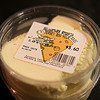
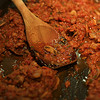

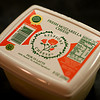
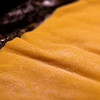
Quick Italian Sausage
1 pound ground pork (at least 30% fat)
1T kosher salt
1T fennel seed
1-1/2 tsp coarse black pepper
3/4 tsp sugar
2-3T ice cold water
Mix all ingredients together well. Fry a small test patty to taste for salt and seasoning, and adjust as needed. Let sit overnight, if possible, to allow flavors to blend.
Dark Days challenge, Italian, locavore, meat, recipes
5 Comments »




Posted by Anita on 11.19.08 11:31 PM
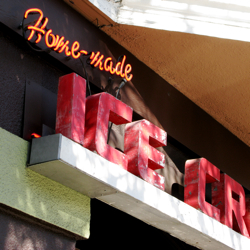 What do you do when one of your favorite foodies comes to town, and specifically mentions wanting to stroll through The Mission? Why, you plan an itinerary that takes you past some of the neighborhood’s favorite places to buy delicious treats!
What do you do when one of your favorite foodies comes to town, and specifically mentions wanting to stroll through The Mission? Why, you plan an itinerary that takes you past some of the neighborhood’s favorite places to buy delicious treats!
After shopping our way through the Ferry Plaza Farmers Market together, we left Laura to explore on her own for a few hours. (We hit Rainbow Grocery for a few staples, then headed home to put our perishables in the fridge.) We met up at high noon at 16th Street BART. Seeing as how it had been ages since we stuffed ourselves with Mexican breakfast at Primavera, we decided a traditional San Francisco burrito was in order. We stopped at Taqueria El Castillito — an old favorite, but definitely not local, sustainable, or organic in any way — and fortified ourselves with burritos and a torta, and a few bottles of Mexican cane-sugar sodas.
Back out into the bright sunshine — it’s always sunny in The Mission, but Saturday was unseasonably hot — we trekked down Mission to 18th. Trying to keep to the shady side of the street, we pointed out the retaurant row that is 18th and Guerrero (Farina, Tartine Bakery, Delfina, and Pizzeria Delfina) but did not stop to join the monster queues. We’d really just planned to peek into Bi-Rite Creamery, but the short line — full of surprisingly happy ‘No on 8‘ protesters — and list of fabulous flavors tempted us. We couldn’t let Laura leave San Francisco without a taste of the famous Salted Caramel ice cream, could we? (Cameron also sampled the malted vanilla with peanut brittle, just to make sure we’d covered all the bases.)
Across the street, Bi-Rite Market was sampling their Thanksgiving offerings from a catering station on the sidewalk. We smelled the heavenly aromas, but couldn’t even consider a nibble. We pressed inside the store along with everyone else in the entire neightborhood, taking a peek at all the fabulous local produce and the justifiably famous deli case. (I still don’t understand how Sean and DPaul lived around the corner for years without weighing 300 pounds. I’d never cook!)
Backtracking to Valencia Street, we strolled past Range — where we’d enjoyed a fabulous dinner the previous night — and popped into Lucca, one of the last remaining vestiges of the Mission’s Italian heritage. We browsed the aisles, admiring the terrific assortment of goodies, then headed back out into the street. I think I always knew that Lucca makes their ravioli on the premises, even noted the minuscule factory visible through the picture window along Valencia, but I’d never timed it right to see the process in action until this week. We stood with our noses pressed to the glass for what must have been half an hour, watching as a pair of flour-dusted pasta makers heaved giant wads of dough through an industrial sheeter, then picked them up like so much dirty laundry and magically unfolded them along a table the size of most San Francisco living rooms. (I could descibe the whole process, but Laura’s slideshow does a much better job.)
We picked up the pace and continued down Valencia to 23rd, then down Mission to 24th. After a quick stroll through the Mexican produce stalls and flower shops, we stopped into Philz to let Cameron caffeinate himself with a fine Turkish-style fiter-drip blend, while Laura and I rested our eyes and feet in the cool, dim surroundings.
Our last stop took us to a rendezvous with some of our fellow bloggers at Mission Pie. We were nearly stuffed, but somehow made room to share a slice of double-crust apple pie and another of pear-raspberry galette. When Jen arrived, she showed us the error of our ways, generously offering nibbles of the godly walnut pie (with a gooey center like pecan pie); I now understand why people drive across town to buy a slice. We sat at a big table together in the now-waning afternoon sun, marveling at all the shop’s gorgeous, quirky details — a map of the farms that sell their produce to the pie-makers, a collection of antique egg scales, and some of the coolest light fixtures in the city — chatting about everything from Yves St. Laurent to antique tractors to …well, food, of course.
If we’d only had an extra stomach, we could have kept walking all day.
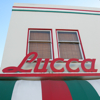


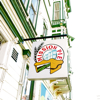
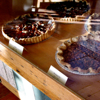
Taqueria El Castillito
2092 Mission Street (x17th)
San Francisco, CA 94110
415.621.3428
Bi-Rite Creamery
3692 18th Street (x Dolores)
San Francisco, CA 94110
415.626.5600
Bi-Rite Market
3639 18th Street (x Dolores/Guerrero)
San Francisco CA 94110
415.241.9760
Lucca Ravioli Company
1100 Valencia Street (x 22nd)
San Francisco, CA 94110
415.647.5581
Philz Coffee
3101 24th Street (x Folsom)
San Francisco, CA 94110
415.875.9370
Mission Pie
2901 Mission Street (x 25th)
San Francisco, CA 94110
415.282.4PIE
coffee & tea, dessert, Italian, Mexican, other blogs, The Mission
7 Comments »




Posted by Anita on 11.06.08 10:41 PM
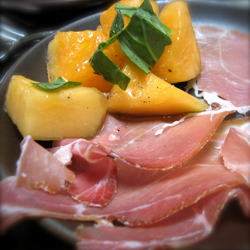 To say that we were not predisposed to appreciate SPQR would be a bit of an understatement.
To say that we were not predisposed to appreciate SPQR would be a bit of an understatement.
We visited A16 — the original Cow Hollow venture from the same restaurateurs — a few months after its white-hot debut, and found nearly everything wanting. Which was probably just as well, because in those days getting a reservation was nearly as difficult as finding a parking spot in this notoriously fussy neighborhood.
So when its sibling SPQR opened up, a little more than a year ago, we rolled our eyes. When the rave reviews came rolling in, we reminded ourselves that the same hype followed A16 for ages; obviously, our tastes were not in line with those of the buzz-makers. And when we heard about their no-reservations policy, that was the final nail in the coffin. I couldn’t imagine schlepping across town just to end up cooling my heels for what were rumored to be multi-hour waits. Nuh-uh, no thanks.
Fast forward to June. I’d left work early and caught the bus to a food event at Fort Mason. As soon as I walked in the door, I realized that there were three times as many guests as there were servings of food, and the claustrophobic crush was unpleasant. I called Cameron and told him not to bother parking, and we sat outside and pondered where to eat on this (to us) foreign side of the City.
“Well…” Cameron ventured tentatively, “There’s SPQR.”
“Oh please,” I sneered. “The food’s going to be terrible, and the line of smooth-haired people will be unbearable.”
But really, we couldn’t think of anywhere better, and we’d developed a serious appetite.
“Let’s just head over that way, and if the line’s too long, we’ll regroup.” (A wise man, this husband of mine.)
We went. We found Doris Day parking. There was no line, but also no open tables — just two seats at the end of the kitchen counter. We pounced.
The all-Italian wine list was a mystery to our California eyes, but with a little help from the staff we found our way to a couple of nice glasses. The decor was right up our alley, all creamy walls and dark-glazed woods and marble countertops, with soaring ceilings and wooden tables. The cooks joked with each other in their close, corral-like space under the watchful gaze of the chef expediting orders at the side of the bar.
I relaxed just a bit, still half-bracing myself for disappointment.
Antipasti — grouped into cold, hot, and fried sections — tempted us. Taking up half the menu, they’re the heart of SPQR’s offerings, and special pricing ($8 each but just $21 for three) encourages you to try a little of a lot. The simple perfection of fresh romano beans sizzled on the griddle with fried chile and breadcrumbs; golden-crisp bocconcini with fresh tomato sauce — a highbrow take on that middle-American favorite, fried mozzarella — and a plate of shaved La Quercia smoked proscuitto and cubes of fragrant melon. Sold!
I turned to Cameron and busted out laughing: “This is my new favorite restaurant!”
Down the other side of the menu we went, ordering what turned out to be far too much food. From the antipasti grande section — which are really entree-sized portions, minus the sides — we opted for saltimbocca with a garnish of piquant giardinara. A generous bowl of rigatoni Amatriciana followed, perfectly chewy tubes bathed in a funky (in a good way) porky tomato sauce. And as soon as we saw the grill guy press a softball-size hank of pork sausage onto the flat-top, we knew we had to have our own order.
Since that sunny summer evening, we’ve returned to SPQR many more times than we can count. We’ve sat at a table or two, and held up stools at the wine bar. But given our druthers, we’ll always opt for those two end seats at the kitchen counter, right in the heart of the action.
The garnishes have changed with the seasons — corn salad changing to braised fennel, or briny olives swapped for canteloupe — but heart of most dishes persists. As fall rolls in, we’re loving the fried brussels sprouts — especially with their new, more-tart dressing — though they can be overdone and greasy now and then. The tuna conserva salad with garbanzos I would happily eat all on its own for lunch, perhaps with a slice of crusty bread. A rotating choice of griddled mushrooms is paired with enchanting grace notes. (Last night, it was chanterelles with tiny pieces of pancetta and a handful of spinach… swoon!) There’s an every-Tuesday special of a local fried chicken, and some eye-popping seasonal additions.
This week’s newest option was the most over-the-top of all: A triple-pork sandwich made of bacon and ham, draped over a breaded-and-fried patty of pigs trotters, served on a chicken-liver-mustard-smeared potato bun. “The kitchen calls it the Widowmaker” our waiter laughed, as she found us yet another stunning wine pairing. Like all of the restaurant’s genuinely warm (and mostly female) front-of-the-house team, she somehow made us feel like her favorite customers while dealing with eight different, difficult tasks.
Oh, and that no-reservations policy? With the exception of one last-minute visit we made late in the evening, we’ve never had to wait. I don’t know if it’s the economy, our timing, or just the natural ebb and flow of restaurant trendiness, but we count ourselves lucky to be able to call SPQR one of our new old standbys.
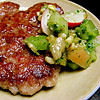
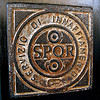
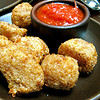

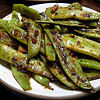
SPQR
1911 Fillmore Street
San Francisco, CA 94115
415.771.7779
Italian, restaurants
2 Comments »




Posted by Anita on 06.07.08 7:18 PM
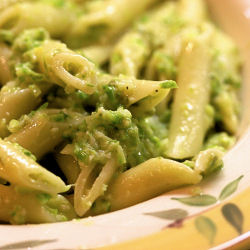 The weekend before last, I noticed a sign hanging from our favorite asparagus stand: “Last week at the market!” Stunned, I quickly grabbed a bunch of fat spears, as though somehow I could prolong the inevitable if I only moved fast enough. I laughed at myself as I paid the farmer, then sighed every time I opened the bag to put something else in: the… last… asparagus. It’s just impossible to believe that this quintessential spring vegetable is already done.
The weekend before last, I noticed a sign hanging from our favorite asparagus stand: “Last week at the market!” Stunned, I quickly grabbed a bunch of fat spears, as though somehow I could prolong the inevitable if I only moved fast enough. I laughed at myself as I paid the farmer, then sighed every time I opened the bag to put something else in: the… last… asparagus. It’s just impossible to believe that this quintessential spring vegetable is already done.
Truthfully, I’ve eaten my fair share of asparagus this spring: Baptized in butter and lemon juice, wrapped in pancetta and roasted, kissed by the smoky love of the grill, shaved raw and stacked with Parmesan shards, pureed into an ethereal chilled soup, topped with a poached egg and sprinkled with buttery breadcrumbs. Truly, my love of sparrow grass knows no bounds; I think nothing of eating it every time I see it on a menu.
But no matter how often I indulge, I’m never ready to see asparagus go. Given my obsession, you’d think — any reasonable person would — that I’d have run home from the market and enjoyed my haul before the dew was dried from its tips. But no, I’m a miser: I squirreled it away, wanting to prolong my personal asparagus season as long as possible.
Maybe I was in denial that the end was near. What other plausible explanation can there be for the fate of that prized bunch of the season’s last spears? Dear readers, forgive me: I left them in the produce drawer all week. Completely and utterly forgot about them, until the weekly fridge-cleanout exposed my error.
 All’s well that ends well, though. Less-than-perfect asparagus gets a new lease on life when whizzed into a savory spring pesto, which in turn makes a more-than-perfect dinner for the inaugural week of One Local Summer. This summertime locavore challenge asks participants to cook a weekly meal from 100% local sources. A stunning 136 participants representing 30 states are joining the festivities, hosted by Farm to Philly with West Coast recaps from a familiar face: Laura at Urban Hennery.
All’s well that ends well, though. Less-than-perfect asparagus gets a new lease on life when whizzed into a savory spring pesto, which in turn makes a more-than-perfect dinner for the inaugural week of One Local Summer. This summertime locavore challenge asks participants to cook a weekly meal from 100% local sources. A stunning 136 participants representing 30 states are joining the festivities, hosted by Farm to Philly with West Coast recaps from a familiar face: Laura at Urban Hennery.
Even between challenges, we’ve still been eating locally as much as we can — nearly every meal we cook at home is made from 85-95% locally grown or locally produced foods. But since One Local Summer only asks us to document one meal a week, we’re going to be stricter on ourselves than we have been in the past. We’ll source everything (even proteins) from within 100 miles, and our only exceptions will be salt and spices. Herbs, oils, sweeteners, even beverages will all come from our immediate foodshed.
—–
But back to the pesto: You might think that a meal made from over-exposed produce and a few pantry staples might taste like a thrown-together mess, but in all honesty nothing could be further from the truth. A judicious removal of all fibrous or discolored bits, followed by a brightening blanch in well-salted water cures a lot of ills when it comes to green veggies. It was our favorite meal of the week, and then some: Cameron and I fought over the leftovers, a sure sign of a recipe that’s bound for heavy rotation — I only wish we’d discovered it sooner.
Along with the neglected Zuckerman asparagus, our pesto contained a good lashing of Bariani’s sumptuous olive oil, a blizzard of Vella dry Jack cheese, sweet blanched almonds from Alfieri Farms, and beautiful young garlic — not quite green, but with still-supple skins and a glorious round flavor — from Green Gulch Farm. Served over Eduardo’s locally made penne, these bright flavors balanced perfectly with the earthy, smoldering notes of Fatted Calf‘s coiled Basque sausage and a fruity bottle of Souverain sauvignon blanc.
A fitting farewell to spring if I do say so myself.
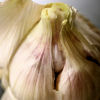

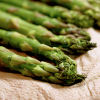
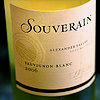
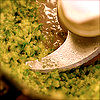
Penne with Asparagus Pesto
1 bunch asparagus (about 1/2 pound before trimming)
8 oz dry penne pasta
1/4 cup blanched almond slivers
2 medium garlic cloves
1/4 teaspoon salt
1/4 cup extra-virgin olive oil
1 ounce freshly grated Dry Jack (about 1/3 cup), plus more for garnish
Fill a Dutch oven or other large pot with water. Salt well, and bring to a boil. Meanwhile, prepare an ice-water bath in a medium bowl.
Snap the woody ends from the asparagus. Cut the stalks into 2-inch lengths, keeping the tips separate. When the water comes to a boil, blanch the stem pieces until they turn bright green and tender, then remove them to the ice bath using a slotted spoon. Repeat with the tips, which should take about half as long. Keep the pot boiling for the pasta while you drain the chilled asparagus well and blot it dry.
In a food processor, pulse the almonds, garlic, and salt until minced, scraping down the sides of the bowl as needed. Add the asparagus and oil, pulsing until the mixture is coarsely chopped — you’re not going for a smooth purée here. Remove the blade from the work bowl, and add the grated cheese. Stir until combined, and season to taste with salt and pepper.
In the same pot of boiling water, cook the penne until al dente. Reserve about 1/3 cup of the pasta water, then drain the pasta. Return the empty pot to the stove over low heat, add the pesto to the pot, then add the drained penne and enough pasta water to create a sauce. Toss well to coat. Taste and season again with salt and pepper as needed.
Serve in shallow bowls, with more grated cheese sprinkled on top.
farmers markets, Italian, locavore, One Local Summer, other blogs, recipes
11 Comments »




Posted by Anita on 10.04.07 7:42 PM
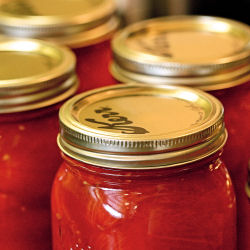 As summer fades into fall, I’m taking great comfort in our pantry full of canned tomatoes. Sometimes I just stand there with the doors open, gazing in at the luxury of summer’s bounty — more than 40 quarts in all — hedged against the privations of winter’s mealy produce. Bought from a local organic farmer at a seriously good price, these tomatoes were picked at their peak of ripeness and processed within 48 hours. Row upon row of jars sit in the cool larder, bright red orbs shining out of the darkness.
As summer fades into fall, I’m taking great comfort in our pantry full of canned tomatoes. Sometimes I just stand there with the doors open, gazing in at the luxury of summer’s bounty — more than 40 quarts in all — hedged against the privations of winter’s mealy produce. Bought from a local organic farmer at a seriously good price, these tomatoes were picked at their peak of ripeness and processed within 48 hours. Row upon row of jars sit in the cool larder, bright red orbs shining out of the darkness.
Gag-inducing, isn’t it? But I must confess that the road all this unseemly self-congratulation was paved with dismal failure.
A few weekends ago, Cameron and I blanched and peeled 40 pounds of Mariquita Farms San Marzano tomatoes. Later in the day, Tea popped over to help us fill cases of quart-sized canning jars with our haul. Seven quarts at a time, we arranged our bounty into the shiny-new pressure canner, sealed the lid, and waited.
We’ve put up jams and preserves for many years, and pickles for at least the last five. But our first foray into the tomato realm was a rather limited success. Almost a third of the jars didn’t develop a proper seal. Of those that did, half lost so much liquid that we feared they would spoil. (Reputable books tell us not to worry: the contents may darken, but they’re safe to eat.) We toyed with the idea of re-processing the unsealed jars, but with no clue as to what had gone wrong and exhausted from a day on our feet, we decided that we’d had enough.
But the next morning, in what can only be described as a “when life gives you lemons” moment, I realized that we had everything on hand that we needed to make a giant batch of pasta sauce. I set the ingredients in a large kettle to simmer, and by bedtime we had dozens of quart-sized bags ready for the freezer. Surplus sauce will not be a problem. We eat our bastardized version of pasta Bolognese every Friday night, as it’s the kind of meal that makes its way to the table with a minimum of fuss. Cameron can whip up a simple salad and a side of garlic bread while the pasta boils, while I pore over my recipe files to plan the next week’s menu.
Determined to correct our mistakes (and unable to resist the siren song of ripe ‘maters), we bought another three crates. That’s 60 more pounds to make 100 pounds in all, for those of you keeping score at home. Guessing that our slightly lackadaisical jar-filling approach had been our undoing, we used a sterilized metal ruler to gauge the gap between the top of the tomatoes and the lip of each jar, ensuring that a half-inch of headspace — and not a millimeter more or less — remained.
Our measuring mania paid off: Not a failed seal in the batch, and a lot less liquid-loss, too. Now that we’ve got our technique dialed in, I can’t wait until next summer to try it again. In the meantime, even our failures yielded some nice side benefits: Our freezer’s overflowing with spaghetti sauce… probably just enough to last us through to next year’s Early Girls.
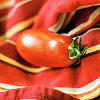

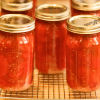

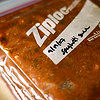
Not-Really-Bolognese Pasta Sauce
2 to 2-1/2 pounds ground meat*
3 cups chopped onion
4 to 6 cloves garlic, minced
12 oz white mushrooms, sliced
1T olive oil
3 quarts home-canned whole tomatoes, undrained (or 3 cans Muir Glen whole peeled tomatoes, with their juice, cut into chunks with kitchen shears)
2 cups tomato sauce
6 oz tomato paste (1 small can)
1 bottle (750 ml) red wine
1T kosher salt
2T dried Italian herbs (we use a combination of 2 parts thyme, 1 part rosemary and 1 part oregano from our garden; if using fresh herbs, triple the amount)
3/4 cup finely chopped flat-leaf parsley
Fry the meat in a large stockpot, breaking up into very small pieces. Add the onion and sweat until soft. Meanwhile, sautee the sliced mushrooms with the olive oil in a separate pan over medium heat until liquid evaporates; do not add salt. When onion is soft, add the garlic to the meat and cook 2 minutes. Drain off most of the fat from the meat and add the mushrooms, tomatoes, salt, herbs, tomato sauce, and tomato paste. Rinse out the tomato cans or jars with the wine, and add to the pot.
Cook for 2 to 3 hours (depending on the amount of liquid in your tomatoes), or until thickened to a dense sauce-like consistency. Add the chopped parsley and remove from the heat. Chill over an ice-water bath to room temperature, then chill overnight if desired. Package in 2-cup quantities in quart-sized freezer bags, and freeze flat.
Each bag will contain enough sauce to coat a half-pound of cooked dried pasta in the American style, to serve 2 to 3. After reheating, we like to add a bit of the pasta water and/or a touch of cream to the sauce before tossing with the pasta, to help the texture recover from the freeze-thaw cycle.
* Our ratio is usually something like 1-1/2 pound ground chuck, 1/2 pound ground pork, and 2 Italian sausages.
Italian, locavore, preserving & infusing, recipes
7 Comments »




Posted by Anita on 06.24.07 8:07 PM
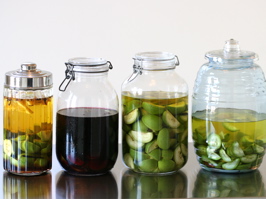 Every June 24, Catholics around the globe celebrate the feast-day of John the Baptist. And every year, on that same day, traditional-minded Europeans head into their local walnut orchards, filling baskets and bags with unripe nuts in order to make nocino, an Italian walnut liqueur, or its French cousin vin de noix.
Every June 24, Catholics around the globe celebrate the feast-day of John the Baptist. And every year, on that same day, traditional-minded Europeans head into their local walnut orchards, filling baskets and bags with unripe nuts in order to make nocino, an Italian walnut liqueur, or its French cousin vin de noix.
We’ve made nocino every summer for the past three years, usually a bit later than the traditional saint’s day due to trouble in our local supply chain. Suffice to say that we lack the necessary ferme, fattoria, or bucolic farmhouse of any sort, and we’ve relied either on nuts shipped from afar or the whimsical schedule of a certain vendor at the Alemany market.
This year, we not only avoided our usual delay, we even jumped the gun a bit. But I hope you’ll agree our motives were good: We were off to Yountville for our anniversary, and I’d remembered reading Shuna’s story last fall about Hoffman Farm, a Napa u-pick with a vast walnut orchard. The idea of making liqueur with nuts we’d plucked ourselves from local trees was simply too attractive to pass up, no matter the date was a tad early.
It took me days to work up the nerve to call John Hoffman and explain what I had in mind. He’d never heard of anyone wanting green walnuts before. “You do know they’re incredibly bitter?” he asked me on the phone. But he graciously allowed that we might stop the coming weekend and pick some nuts, as long as we didn’t come on Sunday morning during church. I assured him that we’d work around his schedule, and would be sure to call before we came, in any case.
Saturday rolled around, bright and sunny. We called Mr. Hoffman to make sure he was home, then donned hats and sunscreen and pointed the car toward Silverado Highway. Just past the intersection with Trancas, we spied the farm’s little sign, a blink-and-miss-it affair. We pulled up the gravel drive and found Mr. Hoffman waiting for us in the shade near his farmhouse garage.
We introduced ourselves and chatted a bit, and he asked me to remind him about what I would do with my early harvest. I explained about splitting the nuts and soaking them in alcohol for most of the summer, then setting aside the strained, sweetened infusion until Christmastime. I marveled that a walnut farmer — and one with Italian in-laws, at that — had never tasted what I’d always assumed was a relatively common homebrew. Not only had he never made it, he’d never even heard of it. Chuckling, he quipped: “Sounds like a waste of a good bottle of vodka,” and winked at Cameron.
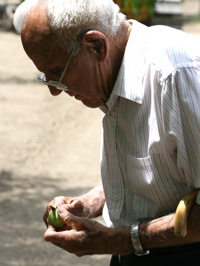 Then he picked up his cane and strolled us out into the orchard. A sun-dappled canopy of walnut boughs stretched as far as the eye could see, all the way back to the crossroads. Mr. Hoffman showed us how to avoid the nuts that suffered from blight — they were few, this early in the season — and how to spy the telltale bore holes of caterpillar infestation. He reached for his pocketknife and cut open one of the few rotten nuts he could find, to show me how the fungus penetrates the hull and works its way to the developing meat.
Then he picked up his cane and strolled us out into the orchard. A sun-dappled canopy of walnut boughs stretched as far as the eye could see, all the way back to the crossroads. Mr. Hoffman showed us how to avoid the nuts that suffered from blight — they were few, this early in the season — and how to spy the telltale bore holes of caterpillar infestation. He reached for his pocketknife and cut open one of the few rotten nuts he could find, to show me how the fungus penetrates the hull and works its way to the developing meat.
It was a botany tutorial, a history lesson, and a glimpse at a disappearing way of life. The Hoffmans have worked this land since the end of World War II. Now, they’re farming one of Napa’s few remaining diversified acreages, as vineyards squeeze out the fruits and nuts that once were the valley’s pride. As Shuna mentions, although the Hoffman land is protected for agricultural use, there’s nothing to prevent these noble trees from being torn out in favor of yet another mass of wine grapes.
After a half hour of picking nuts and snapping photos in the late-morning glow, we brought our canvas sack back to the garage. Mr. Hoffman discussed how to price our unusual transaction while he weighed our haul on his weathered scale. When all was said and done, he refused to take more than a fraction of what we’re used to paying, even when we told him that the going rate was much, much higher. He shook his head like we were citified fools, then added: “You can keep the quarters if you tell me that recipe again.” I smiled broadly and promised to send him prints of the photos we’d taken, plus a few different recipes to try.
We grinned all the way home, amazed at our good fortune in finding Mr. Hoffman — all thanks to Shuna.
After stopping by the local liquor depot for bottles of 100-proof vodka, I quickly set to work halving and quartering the green nuts, measuring sweeteners and spices, and sterilizing my infusing jars. Never had I had the luxury of using nuts picked within hours of infusing, much less 7 pounds worth gathered with my own two hands. Unsurprisingly, we had sufficient nuts for two different batches of nocino — my usual recipe, plus an experiment — as well as a version of Abra’s traditional vin de noix and Lucy’s lighter recipe made with white Burgundy and maple syrup.
I left my quartet of crockery on the new breakfast table for a day or two; they caught the light so beautifully that I wanted to see them (and sneak a sniff of them) all the time. Once the liquids steeped to a black-hole opacity, I followed tradition and put them out in the garden — in this case, the back deck — where they’ll commune with nature for the next 40 days and 40 nights. Then we’ll filter them, bottle them, and wait for the other end of the year, when midwinter brings us yet another celebration of the natural cycle disguised as a religious feast.



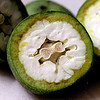

Hoffman Farm
2125 Silverado Trail
Napa, CA 94558
707 226-8938
drinks, holidays & occasions, Italian, locavore, Napa & Sonoma, preserving & infusing
13 Comments »




Posted by Cameron on 05.17.07 5:23 PM
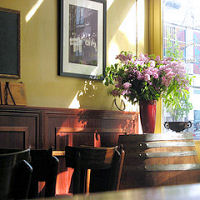 Seattle must have missed us, because she tucked away her raincoat and put on her cutest spring dress for our recent three-day-weekend trip. Not that we would have cared if it had poured rain for 72 straight hours. Well, maybe a little. But the sunshine rounded out an amazing trifecta of food, friends, and fantastic weather.
Seattle must have missed us, because she tucked away her raincoat and put on her cutest spring dress for our recent three-day-weekend trip. Not that we would have cared if it had poured rain for 72 straight hours. Well, maybe a little. But the sunshine rounded out an amazing trifecta of food, friends, and fantastic weather.
As soon as we checked in at the hotel, we headed over to ‘Seattle Customs and Immigration’, better known as the Zig Zag Cafe. Anita has already posted about that stop, but I’ll just add that the joint was as packed as we’ve ever seen it. The revival of the cocktail and a couple of years of steady national press, including a spot for Murray on Playboy’s Top 10 American Bartenders list, have alerted the rest of the world to the magic happening there.
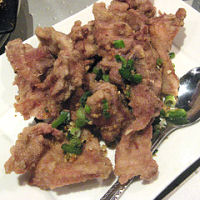 We usually keep to ourselves on our first night in Jet City, but we weren’t surprised to run into several friends at the Zig Zag, including Rocky (a.k.a. Old Two Livers). When the lights went on and the chairs went up on the tables, we followed Rocky to The Purple Dot in the International District. The menu at the Purple Dot reads like a description of a catering accident at the United Nations, and we took full advantage, ordering beef internal delicacies (belly, tendon, and tripe), soup noodles with beef and fish balls, beef curry, spaghetti with ham and chicken, and salt-and-pepper pork ribs. This is stuff that’s meant to be eaten at 3am with a serious load on, but I’d go back for those ribs at any time of day or night.
We usually keep to ourselves on our first night in Jet City, but we weren’t surprised to run into several friends at the Zig Zag, including Rocky (a.k.a. Old Two Livers). When the lights went on and the chairs went up on the tables, we followed Rocky to The Purple Dot in the International District. The menu at the Purple Dot reads like a description of a catering accident at the United Nations, and we took full advantage, ordering beef internal delicacies (belly, tendon, and tripe), soup noodles with beef and fish balls, beef curry, spaghetti with ham and chicken, and salt-and-pepper pork ribs. This is stuff that’s meant to be eaten at 3am with a serious load on, but I’d go back for those ribs at any time of day or night.
Dawn’s early light made way too much noise on Saturday morning, accompanied by a call at 7:30am from our remodel contractor spouting incomprehensible (and ultimately inessential) gibberish. Seeing round out of one eye and square out of the other, we shaped up as best we could and set course for the Steelhead Diner by way of the Daily Dozen Donut Company at Pike Place Market.
 We figured that a mixed dozen baby doughnuts would be essential sustenance for a wait for brunch at the Steelhead, as it was close to noon on a bee-yoo-tifful Saturday. There was no line, but we killed some time snarfing doughnuts and replenishing the world’s stock of pictures of the Market’s famous sign. As it turned out, that bag of pastry would be the best thing that we’d eat that morning.
We figured that a mixed dozen baby doughnuts would be essential sustenance for a wait for brunch at the Steelhead, as it was close to noon on a bee-yoo-tifful Saturday. There was no line, but we killed some time snarfing doughnuts and replenishing the world’s stock of pictures of the Market’s famous sign. As it turned out, that bag of pastry would be the best thing that we’d eat that morning.
Despite a promising menu packed with foodstuffs from local purveyors, the half-empty Steelhead took nearly 45 minutes to deliver disappointment on white plates. The fish portion of my fish and chips was pretty good, but the chips absolutely sucked. The whole plate cost $16, and they didn’t even put bourbon in it or anything. Anita’s eggs Ellenburg — a Sysco-style chicken-fried steak topped with (broken!) fried eggs and a terrible sausage gravy — was stunningly bad.
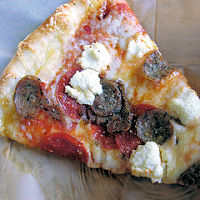 Salvation lay only a couple of hours away. When the mid-afternoon turned peckish, we decided to visit our friend Jason at his ‘office’: Pagliacci Pizzeria in Lower Queen Anne. We ordered a couple of slices, sampled the monthly special ‘za (Portabello Primo: yum!), and re-acquainted ourselves with the sorely missed Pagliaccio salad.
Salvation lay only a couple of hours away. When the mid-afternoon turned peckish, we decided to visit our friend Jason at his ‘office’: Pagliacci Pizzeria in Lower Queen Anne. We ordered a couple of slices, sampled the monthly special ‘za (Portabello Primo: yum!), and re-acquainted ourselves with the sorely missed Pagliaccio salad.
After a quick stop at the hotel to freshen up, we met a crew of friends for drinks at the stylish, strikingly beautiful Vessel. Read Anita’s review and go now: This winning combination of smart, solid cocktails, tasty nibbles, and attentive, welcoming service is already drawing crowds.
From Vessel, we taxi-ed over to Tavolata, a new Belltown Italian venture from Union superchef Ethan Stowell. With a little help from a friendly kitchen, our posse of eight serious eaters managed to sample almost the entire menu. It was all very, very good, right down to the lemon zeppole for dessert. (How can you argue with a day that begins and ends with doughnuts?)
 Two weeks later, Anita is still dreaming about this meal. Ethan’s crew is making most of their pasta from scratch in a basement workroom filled with flour-grinders, dough-extruders, and restaurant-sized rollers. And, while the secondi are glorious — both the Fiorentina-style T-bone and the double-cut pork chop are among the best meat dishes of the year so far — the pasta is amazing and totally different than anything else in town. Out of a near-dozen options, we sampled eight and there wasn’t a clinker in the bunch, from familiar standbys like a heart-stoppingly good rigatoni in tomato sauce to more-adventurous recipes like gnocchi with bitter greens.
Two weeks later, Anita is still dreaming about this meal. Ethan’s crew is making most of their pasta from scratch in a basement workroom filled with flour-grinders, dough-extruders, and restaurant-sized rollers. And, while the secondi are glorious — both the Fiorentina-style T-bone and the double-cut pork chop are among the best meat dishes of the year so far — the pasta is amazing and totally different than anything else in town. Out of a near-dozen options, we sampled eight and there wasn’t a clinker in the bunch, from familiar standbys like a heart-stoppingly good rigatoni in tomato sauce to more-adventurous recipes like gnocchi with bitter greens.
Mind you, this was after we’d eaten our fill of gorgeous starters like cork-shaped fried polenta with bagna cauda, asparagus and fried duck egg topped with shaved Parmesan, octopus and bean salad (which will win over tentacle haters), and house-made mozzarella cheese served with a hazlenut-butter crostino. And they serve all of this gorgeous fare until 1am daily — sure beats the pants off of Beth’s.
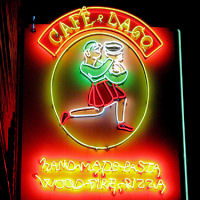 One of the pleasant hazards of visiting our second home city is that we have a long list of ways to complete the sentence, “A visit to Seattle wouldn’t be complete without…” Sunday morning, the Mad Libs answer was, “brunch at Cafe Campagne with friends: ouefs en meurette, ouefs en cocotte, bloody marys, and bowls of cafe au lait.” We filled in another blank later that day with “…pizza and pasta at Cafe Lago,” with Tea and Carla.
One of the pleasant hazards of visiting our second home city is that we have a long list of ways to complete the sentence, “A visit to Seattle wouldn’t be complete without…” Sunday morning, the Mad Libs answer was, “brunch at Cafe Campagne with friends: ouefs en meurette, ouefs en cocotte, bloody marys, and bowls of cafe au lait.” We filled in another blank later that day with “…pizza and pasta at Cafe Lago,” with Tea and Carla.
Our last day was a bit of a struggle, food-wise. Breakfast: indifferent ouefs plats (but fabulous conversation and to-die-for morning light) at Le Pichet. Lunch: Lots of laughter (and friendly staff) at Bernard’s on Seneca, a “morbid curiosity” favorite as much for its “Germans storming the castle” decor as for the surreal food.
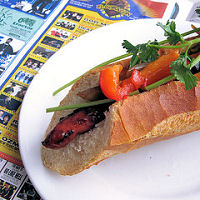 The lone bright spot for our tastebuds on Monday was a pint of cream ale at Hale’s Ales. We knew better than to try and eat at the pub, and decided to grab a pre-flight late afternoon snack at Baguette Box as we passed through lower Cap Hill. Can we say it? We are completely over this place. Every time we go, poor execution torpedoes a nifty “bahn mi-goes-global” sandwich-shop concept. And they’re always out of the first two things I want to eat… argh.
The lone bright spot for our tastebuds on Monday was a pint of cream ale at Hale’s Ales. We knew better than to try and eat at the pub, and decided to grab a pre-flight late afternoon snack at Baguette Box as we passed through lower Cap Hill. Can we say it? We are completely over this place. Every time we go, poor execution torpedoes a nifty “bahn mi-goes-global” sandwich-shop concept. And they’re always out of the first two things I want to eat… argh.
The rain began to fall as we drove south to the airport, and the droplets obscured the glimpses that we were catching of the skirts of Rainier. The distant mountain just barely peeked through the haze that erases her enormous presence even when the day seems clear and bright. We waved and said goodbye. Maybe she’d come out for our next visit — one of the many dear friends that we look forward to seeing again.
ps: You can see photos from all 15(!) food and drink stops in our Seattle Collection.
Purple Dot Cafe
515 Maynard Avenue South
Seattle, WA 98104
206 622-0288
Daily Dozen Donut Company
93 Pike Street (Pike Place Market)
Seattle, WA 98101
206 467-7769
Steelhead Diner
95 Pine Street
Seattle, WA 98101
206 625-0129
Pagliacci Pizzeria
550 Queen Anne Avenue North
Seattle, WA 98109
206 726-1717
Tavolata
2323 Second Avenue
Seattle, WA 98121
206 838-8008
Cafe Campagne
1600 Post Alley
Seattle, WA 98101
206 728-2233
Cafe Lago
2305 24th Avenue East
Seattle, WA 98112
206 329-8005
Le Pichet
1933 First Avenue
Seattle, WA 98101
206 256-1499
Bernard’s on Seneca
315 Seneca Street
Seattle, WA 98101
206 623-5110
Hale’s Ales Pub
4301 Leary Way NW
Seattle, WA 98107
206 782-0737
Baguette Box
1203 Pine Street
Seattle, WA 98101
206 332-0220
bar culture, breakfast, Italian, restaurants, Seattle, travel
2 Comments »




Posted by Anita and Cameron on 04.11.07 7:57 AM
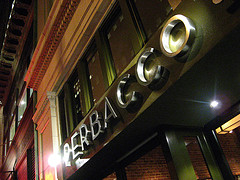 We haven’t been writing a lot of restaurant reviews lately, mostly because life has kept us from eating anywhere new or noteworthy. We’ve also both come to the conclusion (separately, we might add) that writing a negative review, or even a so-so one, is exhausting. You feel the need to justify every criticism, and defend every quibble. And, really, who wants to read our bitchy moaning, especially when it comes to a place that so many other foodies adore?
We haven’t been writing a lot of restaurant reviews lately, mostly because life has kept us from eating anywhere new or noteworthy. We’ve also both come to the conclusion (separately, we might add) that writing a negative review, or even a so-so one, is exhausting. You feel the need to justify every criticism, and defend every quibble. And, really, who wants to read our bitchy moaning, especially when it comes to a place that so many other foodies adore?
But a number of people have noticed our Perbacco shots on Flickr, and asked when we were going to post, so it’s getting to be more work ducking the question than it is to just… come out with it.
Let’s start out by saying we had high hopes for Perbacco. Not unrealistic ones, we hope, but strong expectations buoyed by heaps of affirmative press plus an early report that the chef, a former butcher, spends his weekends curing his own salumi. Truly, a man after our own hearts.
Our initial visit left us disappointed but convinced that the food was worthy if you steered clear of so-so main courses in favor of pastas. We both decided that it was only the colossally amateurish service that prevented us from having the sort of night that we’d gush about. But after a second visit yielded significantly better service but much worse food, we just can’t join the chorus of adulation being sung in Perbacco’s key.
To start with a positive note, the salumi options improved between our first and second visits. Our first time around, the starter menu offered only a single house-cured sausage plate and a large sampler platter, which forced a frustrating choice between a one-note (and, dare we say, stingy?) sampling and an appetite-spoiling array. On our second visit, we were happy to see some more-interesting options: both greater variety and a selection of smaller assortments, each with a different stylistic focus.
But uneven notions of scale and surfeit extend beyond the salumi at Perbacco. All through both meals, the theme continued: Too much, not enough, too much, not enough… like some practical joke played by the kitchen at our expense.
First: Overkill. On our initial visit, Anita loved the taste of her burrata appetizer, but quickly tired of its unctuous, truffled intensity. Cameron’s strongly flavored salad was another tastebud-killer: All the components hung together well, but by the time he was halfway through, the richness of chestnut honey, gorgonzola, and hazelnuts exhausted his palate. On our return trip, Anita’s beet-and-arugula salad offered just too much of the same flavors, over and over, without relief.
Next: Underflavored. Although the feta-like Castelmagno cheese on Anita’s beet-and-arugula salad provided more of a salty kick than was pleasant, the beets themselves were flat and nearly flavorless. On our second visit, Anita’s pasta didn’t appear to have any salt in the dough, and had been dressed with unsalted butter. A cauliflower passata presented a perfect, velvety texture, but didn’t actually taste like its sponsor vegetable — a cauliflower soup for people who dislike cauliflower.
We always feel sorry for chefs who present a traditional Italian three-course menu of appetizers, pastas, and mains. We Americans are so attuned to the pasta-centric dinners we grew up on that it seems almost futile for chefs to run the antipasti-primi-secondi route. We do our best to support the traditional flow when our appetite allows, but the too-variable portion sizes at Perbacco made this an exercise in futility.
We loved the tajarin (hand-cut tagliatelle) with pork-and-porcini sugo as a middle course on our first visit, but an entrée portion that we ordered on our second visit was only a smidge larger — nowhere near sufficient to serve as a main course. Likewise, the sides accompanying all three of the main courses we ordered (two the first visit, one the second) were so skimpy that you wished the chef would just offer his entrees a la carte and be done with it.
And frankly, Perbacco’s entrees are its weakest link. Anita loves milk-braised pork and she’s ga-ga for grits, so Perbacco’s pork shoulder al latte with whole-grain Anson Mills polenta and shredded Savoy cabbage seemed like a shoo-in. But the unappetizingly symmetrical chunk of pig — plated like Lean Cuisine on a small oval dish — lacked the cut-it-with-a-fork tenderness that’s the hallmark this traditionally braised dish. And again, the sides were laughably meager, a criminal offense given their peasant-like affordability. (Could there be anything cheaper than corn mush and cabbage? Why such tiny nibbles?)
Both times we opted for a trio of gelati for dessert. Presented in adorable ceramic dishes made to look like partially crushed Dixie cups, the flavors ran the gamut from delightful (a fleur de sel caramel that tasted identical to a version we made last year) to unpleasant (an overwhelming pistachio).
Sadly, we doubt we’ll take another stab at dinner at Perbacco. We can envision returning for a plate of salumi at the bar, alongside one of their well-made cocktails… especially the Rosmarino. And certainly, if friends suggested we meet at Perbacco, we wouldn’t decline. But for the price — dinner both times hovered near the $200 mark for a full complement of food but minus any blow-out wines or other additions — we can’t afford the gamble of another hit-and-miss meal.
Perbacco
230 California Street (near Front Street)
San Francisco, CA 94111
415.955.0663
downtown SF, Italian, restaurants
3 Comments »




 Trying to plan a suitable entry for this month’s CanJam — the theme is alliums — left us a little perplexed. It’s not that we haven’t been known to preserve onions: I’m a big fan of the bright-pink Yucatecan pickled onions served with cochinita pibil, and Cameron has a special fondness for English-style pub onions.
Trying to plan a suitable entry for this month’s CanJam — the theme is alliums — left us a little perplexed. It’s not that we haven’t been known to preserve onions: I’m a big fan of the bright-pink Yucatecan pickled onions served with cochinita pibil, and Cameron has a special fondness for English-style pub onions. Combine the vinegar, mustard seed, celery seed, chili pepper, and sugar in a 6-quart stainless or enamel pan. Bring to a boil and continue to cook for 3 minutes. Add the vegetables, reduce heat to low, and cook for a few minutes until the vegetables just begin to soften. Remove from heat and discard the chili.
Combine the vinegar, mustard seed, celery seed, chili pepper, and sugar in a 6-quart stainless or enamel pan. Bring to a boil and continue to cook for 3 minutes. Add the vegetables, reduce heat to low, and cook for a few minutes until the vegetables just begin to soften. Remove from heat and discard the chili.








 When you stock your larder with good quality staples, you’re able to create some amazing, quick weeknight meals. We’re lucky to live in a part of the country with access to a year-round supply of pastured eggs, a wide assortment of local artisan-made cheeses, and some truly excellent dry pasta, all from local sources.
When you stock your larder with good quality staples, you’re able to create some amazing, quick weeknight meals. We’re lucky to live in a part of the country with access to a year-round supply of pastured eggs, a wide assortment of local artisan-made cheeses, and some truly excellent dry pasta, all from local sources.




 Farmers and food artisans who created the ingredients for this week’s meal:
Farmers and food artisans who created the ingredients for this week’s meal:

































 Seattle must have missed us, because she tucked away her raincoat and put on her cutest spring dress for our recent three-day-weekend trip. Not that we would have cared if it had poured rain for 72 straight hours. Well, maybe a little. But the sunshine rounded out an amazing trifecta of food, friends, and fantastic weather.
Seattle must have missed us, because she tucked away her raincoat and put on her cutest spring dress for our recent three-day-weekend trip. Not that we would have cared if it had poured rain for 72 straight hours. Well, maybe a little. But the sunshine rounded out an amazing trifecta of food, friends, and fantastic weather. We usually keep to ourselves on our first night in Jet City, but we weren’t surprised to run into several friends at the Zig Zag, including Rocky (a.k.a. Old Two Livers). When the lights went on and the chairs went up on the tables, we followed Rocky to
We usually keep to ourselves on our first night in Jet City, but we weren’t surprised to run into several friends at the Zig Zag, including Rocky (a.k.a. Old Two Livers). When the lights went on and the chairs went up on the tables, we followed Rocky to  We figured that a mixed dozen baby doughnuts would be essential sustenance for a wait for brunch at the Steelhead, as it was close to noon on a bee-yoo-tifful Saturday. There was no line, but we killed some time snarfing doughnuts and replenishing the world’s stock of pictures of the Market’s famous sign. As it turned out, that bag of pastry would be the best thing that we’d eat that morning.
We figured that a mixed dozen baby doughnuts would be essential sustenance for a wait for brunch at the Steelhead, as it was close to noon on a bee-yoo-tifful Saturday. There was no line, but we killed some time snarfing doughnuts and replenishing the world’s stock of pictures of the Market’s famous sign. As it turned out, that bag of pastry would be the best thing that we’d eat that morning. Salvation lay only a couple of hours away. When the mid-afternoon turned peckish, we decided to visit our friend Jason at his ‘office’:
Salvation lay only a couple of hours away. When the mid-afternoon turned peckish, we decided to visit our friend Jason at his ‘office’:  Two weeks later, Anita is still dreaming about this meal. Ethan’s crew is making most of their pasta from scratch in a basement workroom filled with flour-grinders, dough-extruders, and restaurant-sized rollers. And, while the secondi are glorious — both the Fiorentina-style T-bone and the double-cut pork chop are among the best meat dishes of the year so far — the pasta is amazing and totally different than anything else in town. Out of a near-dozen options, we sampled eight and there wasn’t a clinker in the bunch, from familiar standbys like a heart-stoppingly good rigatoni in tomato sauce to more-adventurous recipes like gnocchi with bitter greens.
Two weeks later, Anita is still dreaming about this meal. Ethan’s crew is making most of their pasta from scratch in a basement workroom filled with flour-grinders, dough-extruders, and restaurant-sized rollers. And, while the secondi are glorious — both the Fiorentina-style T-bone and the double-cut pork chop are among the best meat dishes of the year so far — the pasta is amazing and totally different than anything else in town. Out of a near-dozen options, we sampled eight and there wasn’t a clinker in the bunch, from familiar standbys like a heart-stoppingly good rigatoni in tomato sauce to more-adventurous recipes like gnocchi with bitter greens. One of the pleasant hazards of visiting our second home city is that we have a long list of ways to complete the sentence, “A visit to Seattle wouldn’t be complete without…” Sunday morning, the Mad Libs answer was, “brunch at Cafe Campagne with friends: ouefs en meurette, ouefs en cocotte, bloody marys, and bowls of cafe au lait.” We filled in another blank later that day with “…pizza and pasta at
One of the pleasant hazards of visiting our second home city is that we have a long list of ways to complete the sentence, “A visit to Seattle wouldn’t be complete without…” Sunday morning, the Mad Libs answer was, “brunch at Cafe Campagne with friends: ouefs en meurette, ouefs en cocotte, bloody marys, and bowls of cafe au lait.” We filled in another blank later that day with “…pizza and pasta at  The lone bright spot for our tastebuds on Monday was a pint of cream ale at Hale’s Ales. We knew better than to try and eat at the pub, and decided to grab a pre-flight late afternoon snack at Baguette Box as we passed through lower Cap Hill. Can we say it? We are completely over this place. Every time we go, poor execution torpedoes a nifty “bahn mi-goes-global” sandwich-shop concept. And they’re always out of the first two things I want to eat… argh.
The lone bright spot for our tastebuds on Monday was a pint of cream ale at Hale’s Ales. We knew better than to try and eat at the pub, and decided to grab a pre-flight late afternoon snack at Baguette Box as we passed through lower Cap Hill. Can we say it? We are completely over this place. Every time we go, poor execution torpedoes a nifty “bahn mi-goes-global” sandwich-shop concept. And they’re always out of the first two things I want to eat… argh. We haven’t been writing a lot of restaurant reviews lately, mostly because life has kept us from eating anywhere new or noteworthy. We’ve also both come to the conclusion (separately, we might add) that writing a negative review, or even a so-so one, is exhausting. You feel the need to justify every criticism, and defend every quibble. And, really, who wants to read our bitchy moaning, especially when it comes to a place that
We haven’t been writing a lot of restaurant reviews lately, mostly because life has kept us from eating anywhere new or noteworthy. We’ve also both come to the conclusion (separately, we might add) that writing a negative review, or even a so-so one, is exhausting. You feel the need to justify every criticism, and defend every quibble. And, really, who wants to read our bitchy moaning, especially when it comes to a place that